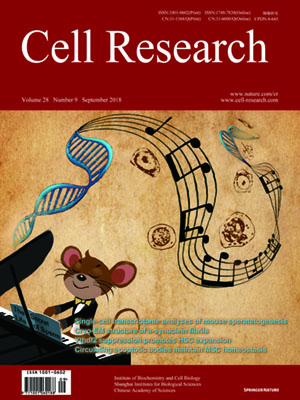
Volume 28, No 9, Sep 2018
ISSN: 1001-0602
EISSN: 1748-7838 2018
impact factor 17.848*
(Clarivate Analytics, 2019)
Volume 28 Issue 9, September 2018: 952-954
LETTERS TO THE EDITOR
Mettl3–Mettl14 methyltransferase complex regulates the quiescence of adult hematopoietic stem cells
Qi Jason Yao 1, Lina Sang 2, Minghui Lin 1, Xiujuan Yin 1,Wenjie Dong 1, Yuping Gong 2 and Bo O. Zhou 1
1State Key Laboratory of Cell Biology, CAS Center for Excellence in Molecular Cell Science, Shanghai Institute of Biochemistry and Cell Biology, Chinese Academy of Sciences, University of Chinese Academy of Sciences, 320 Yueyang Road, 200031 Shanghai, China and 2Department of Hematology, West China Hospital, Sichuan University, 610041 Sichuan, China
Correspondence: These authors contributed equally: Qi Jason Yao, Lina Sang, MinghuiLin.Correspondence: Yuping Gong (gongyuping@hotmail.com) orBo O. Zhou (bo.zhou@sibcb.ac.cn)
Dear Editor,
N6-methyladenosine (m6A) is a common modification of mRNA that is catalyzed by the Mettl3–Mettl14 methyltransferase complex1, with WTAP as its regulatory subunit2. The physiological importance of m6A has been evidenced by its pivotal roles in tissue development and differentiation3,4,5,6,7,8,9. Hematopoietic stem cells (HSCs) are self-renewable multipotent progenitor cells that sustain all blood cell lineages throughout life. It has been well recognized that epigenetic modifications, such as histone or DNA modifications, are implicated in HSC self-renewal10. Recent studies have shown that the mRNA modification m6A also functions in the hematopoietic system. In human, Mettl3–Mettl14-mediated m6A was found to promote the development of acute myeloid leukemia and maintain leukemia-initiating cells5,6,11. In zebrafish and mouse, knockdown of Mettl3 blocked the endothelial-to-hematopoietic transition during embryonic development, thereby repressing the generation of the earliest HSCs7. Surprisingly, deletion of Mettl3 in Vav1-cre; Mettl3fl/fl mouse embryos did not have a significant effect on the number or function of E10.5 fetal hematopoietic stem and progenitor cells (HSPCs)4, suggesting that cell-autonomous m6A is dispensable for HSC self-renewal during early development. Conditional deletion of Mettl14 in adult mice caused a mild but significant reduction of the hematopoietic repopulation ability in recipient mice6. The repopulation defect observed in Mettl14-deficient bone marrow cells could be interpreted as a myeloid differentiation defect or a defect in HSC self-renewal. However, until now, there is a lack of evidence that m6A plays a role in HSC self-renewal in the bone marrow. In this study, we took genetic approaches to investigate the physiological roles of Mettl3 and Mettl14 in the regulation of HSC self-renewal in adult mouse bone marrow.
https://doi.org/10.1038/s41422-018-0062-2
FULL TEXT | PDF
Browse 1295


